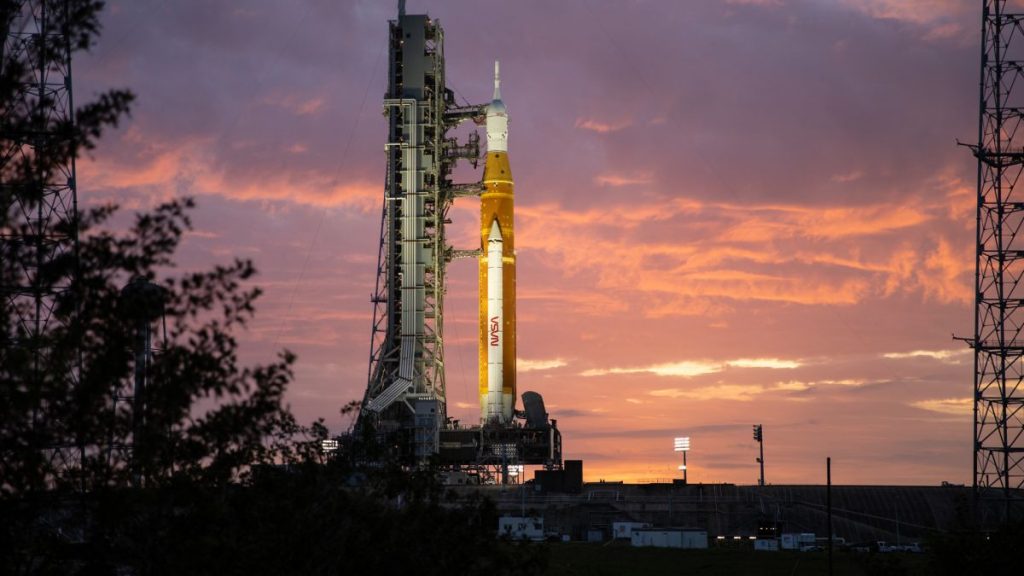While Artemis 1’s rocket and spacecraft are back in the shop for a few more weeks, NASA has released all the launch opportunities the mission has in 2022.
The Artemis 1 moon rocket could lift off for a round-the-moon mission as soon as July 26, although the agency has plotted out dozens of launch possibilities between then and December 22, with even more launch options to the moon through June 2023.
These dates are assuming the Space Launch System passes its wet “dress rehearsal” that simulates fueling operations, and overcomes the problems that required a rollback from the launch pad to the Kennedy Space Center’s Vehicle Assembly Building (VAB) on April 26.
Live updates: NASA’s Artemis 1 moon mission
Related: NASA’s Artemis 1 moon mission explained in photos
Engineers are working to address the hydrogen leak in the umbilical lines and found a damaged O-ring seal that underwent replacement, NASA said in a blog post May 13.
Per NASA, below is the full list of opportunities under consideration on this pathfinder mission to get ready for crewed missions to the moon later in the 2020s. All dates following the July 26 to Aug. 10 window are based on preliminary analysis of the factors needed to get the launch moving to the moon and back, and are subject to change. You can also download NASA’s full Artemis 1 launch window calendar as a PDF.
Here’s a look at the launch windows remaining in 2022.
- July 26 – Aug. 10: 13 launch opportunities, excluding Aug. 1, 2, and 6;
- Aug. 23 – Sept. 6: 12 launch opportunities, excluding Aug. 30, 31, and Sept. 1;
- Sept. 20 – Oct. 4: 14 launch opportunities, excluding Sept. 29;
- Oct. 17 – Oct. 31:11 launch opportunities, excluding Oct. 24, 25, 26, and 28;
- Nov. 12 – Nov. 27: 12 launch opportunities, excluding Nov. 20, 21, and 26;
- Dec. 9 – Dec. 23: 11 launch opportunities, excluding Dec. 10, 14, 18, and 23;
And here are the launch windows for Artemis flights in 2023.
- Jan. 7-20: 10 launch opportunities, excluding Jan. 10, 12, 13 and 14;
- Feb. 3-17: 14 launch opportunities, excluding Feb. 10;
- March: 19 launch opportunities between March 1-17 and March 29-31, excluding March 11 and March 18-28;
- April: 14 launch opportunities between April 1-13 and April 26-30, excluding April 2, 3, 7, 9 and 14-25;
- May: 14 launch opportunities between May 1-10 and May 26-31, excluding May 8 and May 11-25;
- June: 13 launch opportunities from June 1-6, on June 20 and from June 24-30, excluding June 5, 7-19 and 21-23;
“In addition to the launch opportunities based on orbital mechanics and performance requirements, there also is an operational constraint driven by infrastructure at NASA’s Kennedy Space Center in Florida,” NASA noted of the launch dates when they were released on May 16.
“Because of their size, the sphere-shaped tanks used to store cryogenic propellant at the launch pad can only supply a limited number of launch attempts depending on the type of propellant,” the agency added. Essentially, any week only has three maximum launch attempts available due to the core stage tanking process.
Because liquid oxygen and liquid hydrogen are loaded into the core stage and upper stage on launch day, engineers must wait 48 hours to make a second launch attempt. A third attempt must wait an additional 72 hours, “due to the need to resupply the cryogenic storage sphere with more propellant from nearby sources,” NASA said.
NASA outlined four main constraints when it comes to planning launch dates, aside from the fueling operations.
The first is to make sure that the moon is within reach of the massive SLS rocket’s upper stage, which will perform a trans-lunar injection to move the Orion spacecraft towards the moon. Orion will then fly in a distant retrograde orbit. (Retrograde means that it will orbit the moon in the opposite direction to that in which the moon spins.)
The second constraint is making sure Orion’s solar panels are not out of the sun for more than 90 minutes, so that the spacecraft has enough electricity to operate and to stay at a healthy temperature range. Orbital dynamicists must take into account the positions of the Earth, moon and sun (which pull upon the spacecraft with their gravity) as well as the “state of charge” on the battery to plot this out properly.
The third constraint is making sure Orion can perform a “skip entry” when returning to Earth, which is only allowable with certain launch dates. Orion will use the upper part of Earth’s atmosphere, along with its inherent lift, to slow down a bit while skipping deliberately out of the atmosphere temporarily. Then it will re-enter for final descent and splashdown.
“The technique allows engineers to pinpoint Orion’s splashdown location and on future missions, will help lower the [gravity] loads astronauts inside the spacecraft will experience, and maintain the spacecraft’s structural loads within design limits,” NASA stated.
Lastly, Orion must launch at a time to allow for daylight recovery conditions after splashdown to assist in recovery operations. This will be especially crucial when people are on board.
The launching date of the mission will also determine how long Orion is in space. The mission will either be between 26 and 28 days long, or between 38 and 42 days.
“The mission duration is varied by performing either a half lap or 1.5 laps around the Moon in the distant retrograde orbit, before returning to Earth,” NASA said.
Follow Elizabeth Howell on Twitter @howellspace. Follow us on Twitter @Spacedotcom or on Facebook.

